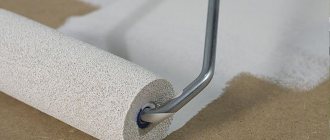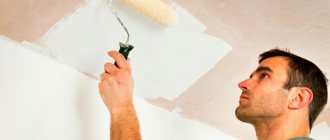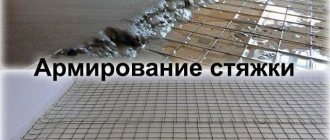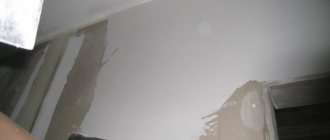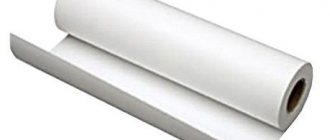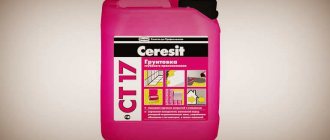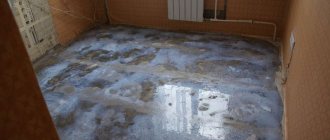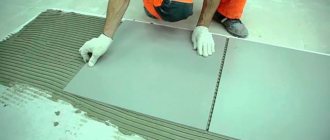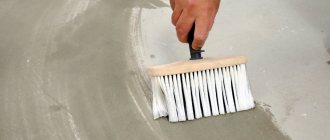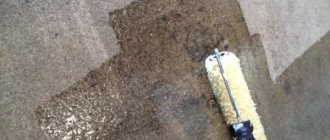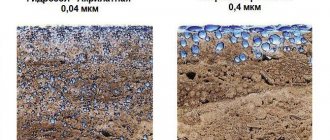Forming a perfectly flat floor is the main task performed during the renovation process. Self-leveling flooring is ideal for this purpose. In addition to the smooth surface, the self-leveling floor has a number of additional advantages (strength, resistance to moisture and temperature changes). In order for all these qualities to be preserved for a long time, the rough surface must be primed with a special compound.
Do you need primer for a self-leveling floor before and after pouring?
It is especially important to apply a primer for loose mineral screeds. Without it, sand and cement dust stain the concrete, reducing the strength of the pour. Surfaces made of wood, stone, brick, concrete, when a solution is poured onto them, strongly absorb water, thereby contributing to the rapid thickening of the mixtures. This affects the hardening time and the consumption of the amount of fill.
Note! Without the adhesive properties of the primer, cracks, cavities, air bubbles, and separation from the base base may form on the self-leveling layer. Uneven spreading of the solution is also possible.
The water present in the emulsion, together with the adhesive, is able to penetrate deeply into the pores of the base before evaporation. The polymer composition together with the resins, remaining on the surface, holds the base together without interfering with the passage of air masses through them. This is of great importance for apartments and residential premises.
Which primer to choose for concrete screed
There are a huge number of soils that differ not only in composition and intended purpose, but also in the form of release and the degree of impact. We will talk about primers for self-leveling floors.
Biocidal primer for concrete screed
Combines antiseptic and adhesive properties. It contains water, acrylic dispersion, nanofungicide and other additives. There are no substances toxic to people and animals (chlorine, heavy metals), and can be used in any climatic conditions.
The properties of the biocidal primer make it indispensable for residential construction and clearly answer the question of whether it is necessary to use polyurethane and epoxy primers or to prime the screed:
- Strengthens the concrete base for the poured floor and protects it from bacteria, microbes, fungus and moss, destroys existing lesions.
- Applying a primer to the surface enhances the adhesion of the base to the self-leveling mixture, while maintaining its breathability.
Polyurethane and epoxy primers
Polyurethane and epoxy primers are considered the best for strengthening concrete screeds, since they contain a hardener and resin.
They are divided by viscosity: soil for deep impregnation is less viscous, a thick composition is used to seal cracks and level the surface. They are easy to apply, significantly increase adhesion and reduce the consumption of self-leveling mixture.
Primers with high adhesive and hydrophobic properties
Designed to protect the concrete base from moisture. Contains organic silicon compounds. The disadvantage of this type of soil is that over time their protective properties lose their strength.
Silicone primers
They are very elastic, with excellent hydrophobic penetrating action; they can even be used to prime raw concrete.
Primer "Betonokontakt"
A universal product based on acrylic with the addition of glue and quartz sand.
It dries quickly, is very resistant to moisture and forms a waterproof film, greatly enhances adhesion, and also retains its properties for a very long time.
Types of primers, which one is best?
The whitish translucent liquid is based on water, drying oil, synthetic resins, various chemical compounds, and a substance that speeds up the drying process. A peculiar thread-like structure remains on the surface, facilitating the bonding of the base to the fill. All soil compositions differ in their composition, characteristics, properties, protection against fungal mold, and methods of application.
According to the intended purpose, the primer can be universal, specific, deep and normal penetration, sold in dry, liquid and paste form. Dry mixtures are diluted with water before use; emulsions in liquid and paste states are ready for use immediately.
Important! To destroy pathogenic fungi and bacteria, chemicals in the form of fungicides are added to the mixture, for better adhesion to a slightly porous base - latex, for resistance to moisture - silicone.
The self-leveling composition can be based on acrylic, alkyd synthetic resin, epoxy, or glyphthalene mixture.
The primer is applied both under self-leveling floors and on their finished surface. The composition of the soil should match the self-leveling floor, so they better complement each other.
Why is deep penetration soil needed?
Let's consider what properties soil mixtures have and whether it is necessary to prime the self-leveling floor. Priming the base for self-leveling floors requires careful preparatory work. Without thorough cleaning of varnish, paint, oil and bitumen compounds, and removal of dust, there cannot be a high-quality filling of leveling material. Using a primer:
The primer helps prevent air bubbles, cavities, small cracks, bumps, and other defects in the fill. It clogs microscopic pores and improves the mobility and spreadability of the solution.
Note! The primer is an integral part of the process of self-leveling floors, regardless of the basic components of the surface and its further laying with any of the coatings.
Why do you need a primer?
A primer is a mixture necessary to improve the quality of the rough surface, allowing for improved adhesion of the finishing layer and the base. Almost all types of subflooring have one drawback - they tend to absorb water excessively and often draw it out of the mixtures used to level the floor or finish it.
On a note! A floor that has absorbed water loses its strength characteristics and wears out quite quickly. Wood and concrete are especially prone to absorbing moisture. And metal surfaces when interacting with water begin to become covered with rust.
Concrete floor primer
Also, with active exposure to water, colonies of microorganisms, fungus, and mold can grow on the surface of the subfloor. They negatively affect human health, smell unpleasant, and also spoil the base material.
When applying a primer layer to the base, the adhesion of its surface to the finishing layer improves. Thus, water will no longer penetrate between the self-leveling floor and the subfloor.
Attention! If water gets between the self-leveling floor and the base, the former may rise. As a result, you will have to completely change the coating, which means additional costs and unnecessary work that can be avoided if you do not violate the installation technology.
DIY self-leveling floor
Thus, the primer ensures the closure of all, even very small, pores on the surface of the concrete, which will not allow moisture to affect the pouring surface or penetrate from the outside into the concrete screed. The primer creates a kind of film on the screed, which will also reduce the consumption of the finishing material - it will not be absorbed into the rough base.
Primer for self-leveling floors on an organic basis
To summarize, it can be noted that a primer for self-leveling floors is necessary for:
- protecting the surface from the development of mold and mildew;
- improving the adhesion of the base and finishing coating;
- protecting the base from moisture;
- improving the performance properties of the material.
The primer improves the adhesion of the base and topcoat
Applying primer mixtures before pouring the floor
Self-leveling floors for rough work contain binders in the form of cement or gypsum. The filler can be rounded sand, crushed rock, crushed stone, various plasticizers and modifiers.
Self-leveling compounds can serve as a base for covering with laminate, linoleum, parquet, carpet, and tiles. Priming before pouring requires knowledge of each type of surface to be treated.
Aerated concrete needs a water-repellent soil of deep penetration, with good permeability into the pores. Brick - in latex, concrete and wood - in acrylic. Highly porous surfaces require a fixing primer. In swimming pools, rooms such as saunas, baths, where there is high humidity, the soil can be replaced with soluble glass.
Technology of applying primer for self-leveling mixtures
First of all, you need to get rid of dirt on the subfloor. The concrete floor is cleaned dry, using a spatula to remove and scrape off all layers and dust remaining after pouring the screed. If the surface seems clean, then blow out all joints and crevices with compressed air. You should not wash or use water before applying a primer, even an acrylic one. Any remaining moisture can “raise” the self-leveling floor a couple of weeks after the layer has polymerized.
Apply the mixture to concrete
The soil is mixed with a mixer immediately before applying the material. There is no point in waiting for the bubbles to go away; they add additional plasticity to the mixture. Unlike a self-leveling floor, the soil is always liquid, so bubbles are easily squeezed out with the bristles of a brush or roller. The primer application scheme is similar to painting; it is necessary to accelerate the mixture, successively changing the direction of movement of the tool. The consumption will be 350-400 g/m2.
The second pass can be done as soon as the first layer has dried to the touch. The consumption for the second layer is 200-250 g/m2.
The priming process is similar to painting
Applying primer over self-leveling floors
Self-leveling surfaces harden quickly, usually within 8 hours. But it gains strength only after 20-28 days. There are different covering times, it all depends on the type of binders in the composition:
Before any covering, the subfloor is primed. Thanks to it, the degree of absorption is leveled. The finishing applied over the primer is applied in an even layer, the paint and varnish materials do not lose their structure and color uniformity, and the consumption of adhesive mixtures and paint is reduced.
Work order
Before applying primer to the base of future self-leveling floors, it is prepared. Remove any dirt, grease stains, soot, and vacuum the surface. Sinks, recesses, cracks are sealed with mortar, all kinds of tubercles are leveled. The primer is applied by spray, roller or wide brush. The brush is not suitable for large areas.
The first primer is allowed to dry for 5 hours, then priming is repeated. The mixture is applied to the surface in even layers. The more evenly it is applied, the more uniform the drying surface will be. Epoxy and polyurethane primers take the longest to dry. Their drying time can reach 2 days.
The quality of the primer is affected by the temperature and humidity of the room. It should not fall below +10°C and rise above +30°C. The room can be subjected to through ventilation only after the soil has completely dried. Before this, you should avoid drafts in the rooms.
Compositions of polymer primers
The selection of soil should be carried out depending on the need and the material that will be used for filling.
Epoxy primers
Suitable for concrete, a mixture of concrete and asphalt, and wood. Epoxy primers are considered ideal for strengthening concrete screeds and increasing their service life.
Due to the nature of curing, all epoxy primers are produced in a two-component form - the main composition and the hardener in different containers. Those soils that are used for deep impregnation have low viscosity. Thick solutions are used for additional sealing of defects, cavities, and preliminary leveling of the base. A good option would be to combine epoxy primers and epoxy self-leveling floors.
Polyurethane primers
Excellent for application under self-leveling polyurethane floors. They can be combined with different types of bases - concrete, cement-sand screed, metal, wood and even ceramic tiles.
If the concrete strength is low or the coating is old, it is better to replace polyurethane primers with epoxy ones - the latter will be more effective. To reduce the cost of work, you can apply the first layer with epoxy primer, the second with polyurethane.
Acrylic and latex primers
Such compositions are best suited for preparing wood and gypsum screeds for pouring floors. In terms of their ability to strengthen concrete, acrylic and latex in the form of primers are inferior to polyurethane and epoxy resins. They are not suitable for sealing cracks and defects in concrete foundations.
Methyl methacrylate primers
Dries very quickly and hardens completely. High rates of adhesion and hiding power, although in terms of depth of penetration into concrete, these compounds are worse than epoxy and polyurethane products.
Due to the rather high cost, methyl methacrylate primers are used primarily for emergency repairs of premises and repairs of individual sections of the floor.
Combination with floor coverings
Before choosing a primer mixture, it is worth familiarizing yourself with the types of floor coverings. The laminate is based on recycled wood. The primer will give the laminate increased adhesion to the base, and the hydrophobic layer will protect the base from moisture. Special antiseptic compounds prevent pathogenic and mold fungi from penetrating into the substrate. An epoxy primer mixture is best suited for laminate and parquet.
Before laying ceramic tiles or tiles, the surface is treated with an acrylic or alkyd primer. They are versatile and quite durable.
Polyurethane with increased wear resistance and water-soluble soil are suitable for covering with linoleum. The advantage of water-soluble is that it is the cheapest, quick-drying, organic, with great penetration depth and strength.
It is not advisable to use alkyd, glypthal or polystyrene primers with a rough self-leveling coating. They have a narrow specialization. Reacting with floor coverings can cause damage.
Primer occupies an important place in pouring technology. For a high-quality and durable coating, you cannot do without it, otherwise all the labor-intensive work of pouring the base and covering it with the finishing material will be ruined.
Technology for pouring self-leveling flooring in an apartment
Concrete floor priming technology
Technology of pouring self-leveling floor on a wooden base
Do I need to prime the walls before laying tiles?
Source
Preparing the floor surface
The preparatory stage must be treated with due attention; the quality of the final result largely depends on this stage. Here it is important to create a level base so that pouring the self-leveling floor can be done without difficulty, and the coating will be beautiful and even. This especially applies to the process when they are going to fill the base with a transparent self-leveling floor to get unusual floors.
If the surface is not new, then it may be necessary to remove poorly adhering areas of the old material, for example, old paint. In any case, it is necessary to remove all dirt so that no dust remains. For this purpose, it is necessary to rinse the surface. If required, pour a cement screed or use a self-leveling mixture.
It is necessary to repair all defects and seam parts to obtain a smooth surface. Then the base is sanded and the resulting dust is removed. The preparation stage can be considered complete, but the surface can only be primed after the floor has completely dried.
To avoid mistakes, check the quality of drying by stretching the film onto the surface, look at it after 24 hours, if no condensation is detected on the films, then proceed to applying a primer. If moisture appears, then wait a couple more days to obtain a dry base.
The joint elements, as well as the corner parts, can be leveled by treating them with sealant.
The preparatory stage must be treated with due attention; the quality of the final result largely depends on this stage.
Self-leveling floor primer
When, during a major overhaul, the need arises to completely replace the old floor with a new one, in most cases preference is given to self-leveling floors. This is because it has a fairly large number of positive characteristics:
However, one should take into account the fact that in order for a self-leveling floor to actually have all these advantages, the base for it must be carefully prepared. And one of the most important stages is priming the surface.
Such building material as primer is presented in a fairly wide range on the construction market. On the one hand, this is good, but on the other hand, the buyer may face a serious problem. After all, choosing exactly the type of primer you need from such a variety is quite difficult. Especially if knowledge in this area is not so extensive.
When to use a deep penetration primer
This type of primer is used during the process of pouring the floor, in rooms with high levels of humidity and frequent changes in temperature conditions. Such premises include baths, saunas, and swimming pools. Since the floor here is in constant contact with water, standard soil for a domestic space is not enough; it is the deep penetration effect that is important. Application of the composition makes it possible to clog the wide pores of concrete, thereby creating an additional protective layer responsible for the safety of the coating.
What to consider
In order to choose the right primer, you need to know exactly what base the self-leveling floor will be applied to. If you want to experiment, then, of course, this is possible, but without preparatory work, the final result will not be so happy. Indeed, in most cases, self-leveling floors are mounted on a concrete base, which in turn contains quite a lot of defects such as:
Moreover, the concrete base also absorbs moisture very well. As a result, the service life of the finished self-leveling floor is greatly reduced.
If we talk about bases that are made of wood and metal, then they also tolerate exposure to high humidity extremely poorly. And if water gets under the surface of the self-leveling floor, they will rise and excellent conditions will form under them for the development of mold and mildew. Dealing with such “pests” is extremely problematic, just like dismantling the self-leveling floor and reapplying it. At a minimum, this procedure is very expensive.
And therefore, to prevent such trouble from happening, it is still necessary to pay maximum attention to the preparatory work, part of which is the process of applying the primer. If the preparation is poor, then as a result all efforts to lay the self-leveling floor will be nullified.
For example, if we are talking about rooms where the humidity level is very high, then the primer should be selected with the ability to penetrate deeply into the surface. A good option would be to purchase liquid glass, which has excellent waterproofing properties. As a result, all the pores and voids that the concrete surface has will be filled with a waterproof layer.
In the event that the humidity level does not increase, you can choose a concrete contact composition. But you should remember that it is not recommended to use compositions made on the basis of acrylic and alcohol as a primer for self-leveling floors. The fact is that they do not guarantee a sufficient level of adhesion, and therefore, when the self-leveling floor hardens, it can simply rise. But it is precisely the high level of adhesion that guarantees that the finished floor will last long enough and will not present unpleasant surprises in the future.
In any case, if self-leveling flooring is chosen as the flooring material, then strict adherence to the technology will save time, money and the nervous system!
So, when choosing a primer, you should take into account what material the base is made of, as well as how it is used:
You can also use silicone compounds as a primer, which significantly reduces repair work and promotes moisture evaporation. You can also use epoxy paint, which will not only protect the base, but also make it look more aesthetically pleasing.
Primer selection
The main function of the primer is to fill uneven areas and ensure adhesion. It also protects building materials from excess moisture. They are produced in the form of liquid solutions or powders.
When choosing, you need to focus on the material from which the base is made and the conditions of use:
- For a concrete base, any available type of primer is suitable, with the exception of acrylic and alcohol-containing ones.
- In places with high humidity, “Liquid glass” or a deep penetration composition is used. They are expensive, but fully justify their price with further use.
- For a ceramic base, polyurethane varnish is used.
- In living rooms, you can get by with ordinary concrete contact. This method is not suitable for a bathroom or swimming pool.
- In a private house, compounds with a bactericidal effect are used under self-leveling floors. They will prevent fungus and rot from spreading.
- For rooms where aggressive chemicals may be on the floor (in a workshop, auto repair shop, garage), polyurethane primer would be the best choice. Its cost is high, but it is also consumed much more economically. But he is not afraid of any “poisonous” compounds.
- The silicone composition is interesting in that it can be applied even to wet screed, which significantly reduces the time of repair work. In addition, it promotes the evaporation of moisture and does not allow it to re-form on the surface of the floors.
- Epoxy paint will perform two functions at once: it will prepare the base and give it an aesthetic appearance.
The use of primers under any floor covering is worth the time and money spent. By using them to protect the floor from microorganisms and ensure good adhesion, you will receive an excellent quality coating that will meet all the declared characteristics. Pay careful attention to this stage of finishing, selection of materials and you are guaranteed to get a high-quality result. You can find prices for materials here.
Forming a perfectly flat floor is the main task performed during the renovation process. Self-leveling flooring is ideal for this purpose. In addition to the smooth surface, the self-leveling floor has a number of additional advantages (strength, resistance to moisture and temperature changes). In order for all these qualities to be preserved for a long time, the rough surface must be primed with a special compound.
How to apply primer
Now let's talk about how to apply the primer correctly so that the self-leveling floor lasts as long as possible. First, you need to thoroughly clean the entire work surface of debris, dirt and dust. If there are remnants of old finishing materials on it, then they also need to be removed. Secondly, you need to apply a screed to the subfloor. This should be done with maximum care and strictly to the level.
When the screed is completely dry, you should take a damper tape or a high-quality sealant, which will be used to seal all the joints between the finished screed and the walls. Next you need to thoroughly sand the screed. The surface should be perfectly smooth. All dust that remains after grinding must be removed, and the cleaned surface is opened with a primer.
You need to choose a primer that can penetrate deeply into the base. It is best to use a clean roller for application!
It is worth noting that the advisability of applying screed is not always justified. This is only necessary if the base of the subfloor is not in perfect condition. If the base is level, then the self-leveling floor can be applied immediately after the surface has been thoroughly primed. The option with a screed is ideal for cases where the floor is finished in an apartment building or in a room where the humidity level is very high.
And in general, the service life of the finished coating depends entirely on how high-quality and level the base for the self-leveling floor is!
Primer before screed
The corresponding topic also needs detailed study. During the execution of work, one cannot do without professionalism and strict adherence to technology. The easiest way is to figure out whether the floor needs to be primed before screeding, because it is much more difficult to resolve other nuances. First of all, in this case, you should start from what kind of coating will be applied subsequently. For wooden floors, an acrylic primer is best. Thanks to the use of the appropriate mixture, the top layer of wood will be properly loosened, which will allow you to apply a layer of paint on it without any problems.
For the purpose of impregnating a concrete base, it is better to give preference to an epoxy primer mixture. Subsequently, the surface will be reliably protected from the penetration of excess moisture. The primer can be applied even on still wet substrates. However, experts recommend waiting a while and giving them a chance to dry.
If you find an error, please select a piece of text and press Ctrl+Enter.
Self-leveling floors are increasingly becoming part of our lives - they can be found in premises for various purposes, including apartments. However, the filling technology is complex and requires attention and accuracy, since it is quite easy to make a mistake and ruin the whole work. A primer for a self-leveling floor is very important; you cannot do without it if you want to make a high-quality and durable coating that can last for many years.
Primer for self-leveling floor
Filled floor
Good day to all! Please tell us the minimum required conditions for a poured floor. Is it possible to immediately lay parquet or Lenolium on it?
Masters online: 31 Orders per week: 1,452 Offers per day: 837
hello, first you need to check the level of the base, if the difference is more than five cm, then I recommend that you first fill the subfloor along the beacons with sand concrete, wait a week for drying and then fill in the leveler for the floor, if the difference is small, then you can fill the leveler right away, but to lay the laminate it is better to wait at least a week
The minimum necessary conditions for a self-leveling floor are to have a surface on which to pour it - if you mean “self-leveling floor”, the main thing is to prime it before pouring. Well, then you can put any finishing material on top, the main thing is that it dries well, otherwise in a year or two, three mold may come out.
With any self-leveling field, the main condition is to let it dry thoroughly
Dear Andrey. To install a leveling mixture, it is necessary that the base be dry, strong, free from dust and cracks. The base also needs to be well primed. Laying the floor covering can only be done after the leveling mixture has completely dried. It is better to lay parquet and solid wood on plywood, and the leveler is better suited for linoleum, interlocking parquet boards and laminate
Andrey, you need to dry it for at least 3 days, and then you can do it.
if you mean a self-leveling mixture, then then comes the substrate and laminate, linoleum
parquet is not allowed. if the floor is cement-sand, it will take 21 days until the moisture is completely released. Laminate is possible, since you still have to put a vapor barrier underneath it, and parquet boards are the same. Well, Lenolium is not a moisture killer, you can put it down. Don’t hit the baseboard right away; you need to wait three days for the coating to settle down.
With normal air humidity and an average pour thickness of about 30mm, for parquet I keep it for about 2 weeks
Andrey, the necessary conditions for such a floor are written on the bag itself, they are approximately the following: the surface must be dry, flat, primed. And you can lay parquet or linoleum after drying, the approximate period is also written in the instructions. And you can check the drying yourself. Place a piece of polyethylene on the floor, stick it with tape and after a while see if there is any perspiration, let it dry.
How's that going right away? after half an hour? :)) Read, I wrote it myself.
no parquet, linoleum is possible but with a backing
It is advisable to wait until it dries completely
Yes, you can lay parquet and linoleum, but only after the floor has completely set.
nope! it’s like not drying off after a shower!
Under no circumstances, the floor must dry.
if liquid? then it is possible.
Linoleum (if of good quality and across the entire width) can be used under the baseboards.
Can. Pouring the floor is, in principle, the finishing base of the subfloor. The main thing is that it dries well.
We are waiting for your call
yes but after primer
Hello Andrei! The conditions are as follows: Dismantling everything down to the concrete, and priming the floor. After a couple of hours, you can pour the self-leveling floor. You can walk on it after 4-5 hours, but you can lay plywood, parquet or laminate flooring only after 4-5 days. It’s better not to rush. If you want to lay parquet, then you definitely need plywood under the laminate, only an underlay. It depends on how much money you plan to spend on repairs. Good luck to you.
What do you mean by poured floor?
We are ready to start work, call us and we’ll make an agreement
no, not until it dries completely
what disgustingness is this poured floor of yours)))
Linoleum can be laid after a couple of days (so that the moisture evaporates better). I can’t install parquet, but wood is more capricious and takes longer to dry.
Source
Popular primer manufacturers (briefly)
The surface should be primed before pouring with a quality product, then you can be sure that the coating will last longer. There are a large number of primer compositions on the construction market, but not all of them are of good quality or high stability.
If the process is to be done with your own hands, then it is better when choosing to focus on popular brands that have proven themselves to be high-quality mixtures among consumers. You can highlight the products of the brands Ceresit, Knauf, Bergauf, you can also highlight the domestic manufacturer Volma, which produces a series of Nivelir primers, kg. the mixtures are not expensive, and their quality is high.
When choosing, you should study the instructions from the manufacturer, which indicate for which materials it is better to use a specific type of primer solution.
